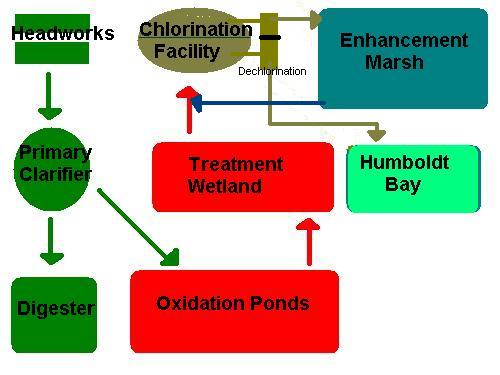Arcata Wastewater Treatment Flow Overview[edit | edit source]
This page follows the general water flow path at the Arcata Wastewater Treatment Facility and Wildlife Refuge. Located in Arcata, California on the tip of the North Coast the plant sits by Humboldt Bay. Here local wastewater is filtered through three treatment steps. This plant is designed to use open ponds to nurture biological life and use it as a filtering process.
The wastewater treatment plant is unique in that the wetlands it utilizes were constructed for the purpose of wastewater treatment. The plant itself was built on a wildlife sanctuary. The WWTP provides suitable habitat and food for plant and animal life which qualifies the plant as "enhancing" the surrounding environment and allowing special discharging regulations to be challenged. 250 migratory bird species make their home here. [1]
Stages of Treatment[edit | edit source]

Primary Treatment: At this stage of treatment solid objects and particles are filtered out of the wastewater to be discarded, digested or removed by skimmer. Primary treatment phases can be seen in Figure 1 in Green.
Secondary Treatment: When solid particles have been removed the organic compounds are broken down by microorganisms. Secondary treatment phases can be seen in Figure 1 in Red.
Tertiary Treatment: At this stage phosphorus and nitrogen are reduced to ensure a level of discharge that will not cause algal blooms in Humboldt Bay. Tertiary treatment phases can be seen in Figure 1 in Blue.
Primary Treatment[edit | edit source]
The first place wastewater is brought on-site occurs at the headworks shown in Figure 2a. Two screw-pumps bring the wastewater into a chamber where solid particles are removed. From the headworks the water travels to the primary clarifier as seen in Figure 2b. There water speed is slowed and particles can be removed as they settle at the top and bottom of the clarifier. The matter removed from the clarifier is moved into a digester, shown in Figure 2c, where the hazardous sludge is mitigated anaerobic processes.
- Photos courtesy of Dustin Poppendeick
-
Figure 2a: Water pipes into the headworks.
-
Figure 2b: The Primary Clarifier
-
Figure 2c: The Digester
Secondary Treatment[edit | edit source]
Water flows into the oxidation ponds, Figure 3a, where algae grows near the surface of the water to help introduce oxygen. The oxygen levels allow bacteria growth that aid in the process of breaking down organic compounds in water.
From the digester water flows into a treatment wetland where algae is then filtered out. See Figure 3b to view the treatment wetland. Notice that the treatment wetland differs from the Oxidation pond in terms of plant coverage. Here algal growth is restricted by the shade provided by the plants. At the treatment wetland plant roots deep down act like a filtering net to take out organic matter as seen in Figure 3c.
- Photos courtesy of Dustin Poppendeick
-
Figure 3a: The Oxidation Ponds
-
Figure 3b: Treatment Wetlands
-
Figuer 3c: Plant roots in Treatment Pond
Tertiary Treatment[edit | edit source]
Wastewater at this point may have a high concentration of nitrogen and phosphorus. The concentrations are mitigated to prevent algal blooms in Humboldt Bay. From the treatment wetland water is chlorinated then dechlorinated and sent to the enhancement wetland which can be seen in Figure 4a Water in the enhancement wetland flows back through the chlorination facility for reuse and dechlorination. At the chlorination plant some of the dechlorinated water is discharged into Humboldt Bay. Figure 4b shows the chlorination facility and Figure 4c shows the point of discharge.
- Photos courtesy of Dustin Poppendeick
-
Figure 4a: Enhancement Wetland
-
Figure 4b: Chlorination Facility
-
Figure 4c: Point of discharge
Other Links[edit | edit source]
- ↑ City of Arcata, History of the Marsh
City of Arcata, History of the Marsh
HSU Arcata Marsh Flow Overview
Hello, I'm Ryan Williamson, and Environmental Science student at Cal Poly Humboldt
Links[edit | edit source]
HSU Env.Science Page
Humboldt_State_University HSU Appropedia page
Waterless Toilet My favorite Appropedia page








